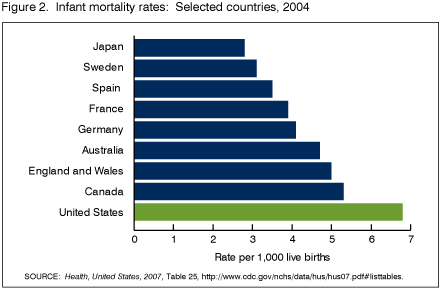Once reserved for cases in which the life of the baby or mother was in danger, the cesarean is now routine. The most common operation in the U.S., it is performed in 31% of births, up from 4.5% in 1965.
With that surge has come an explosion in medical bills, an increase in complications -- and a reconsideration of the cesarean as a sometimes unnecessary risk.
It is a big reason childbirth often is held up in healthcare reform debates as an example of how the intensive and expensive U.S. brand of medicine has failed to deliver better results and may, in fact, be doing more harm than good.
...
The problem, experts say, is that the cesarean -- delivery via uterine incision -- exposes a woman to the risk of infection, blood clots and other serious problems. Cesareans also have been shown to increase premature births and the need for intensive care for newborns. Even without such complications, cesareans result in longer hospital stays.
Inducing childbirth -- bringing on or hastening labor with the drug oxytocin -- also is on the rise and is another source of growing concern. Experts say miscalculations often result in the delivery of infants who are too young to breathe on their own. Induction, studies show, also raises the risk of complications that lead to cesareans.

To read the rest of the article go --->here.
The article goes on to say that despite all of these medical interventions, which the public is led to believe are needed in order to "save lives" (and in some cases are needed and do save lives, I won't deny that), the U.S. maternal morbidity rate continues to rise.
According to recent figures, the U.S. maternal mortality rate was 13 deaths per 100,000 live births in 2004. The rate was 12 deaths per 100,000 live births in 2003 -- the first year the maternal death rate was more than 10 since 1977 (Stobbe, AP/Washington Post, 8/24). A total of 540 women were reported to have died of maternal causes in 2004, 45 more than were reported in 2003, according to the report (NCHS report, 8/21).(1)
What is causing the morbidity rate to rise? Some speculate that obesity, maternal age as well as ethnicity are all factors. However, according to a review of maternal deaths in New York, excessive bleeding is one of the primary causes of pregnancy-related death, and women who have undergone several previous c-sections are at particularly high risk of death.(2)
In conjunction, the U.S. has the highest infant mortality rate amongst developed countries (ranking 29th in the world). The CDC reports that in 2006 the infant mortality rate was 6.71 deaths per 1,000 births.
What is the leading cause of infant death? Prematurity. In 2005, 68.6% of all infant deaths occurred to preterm infants, up from 65.6% in 2000.(3)
 Unfortunately the reason for preterm birth is unknown. However, with the recent rise of "late preterm birth" (infants born at 34–36 weeks gestation) one could guess that the rise in cesarean births could play a part. However, in order to be fair, we must also take into account the rise in multiple births as well as socioeconomic status.
Unfortunately the reason for preterm birth is unknown. However, with the recent rise of "late preterm birth" (infants born at 34–36 weeks gestation) one could guess that the rise in cesarean births could play a part. However, in order to be fair, we must also take into account the rise in multiple births as well as socioeconomic status.I will end this blog with the thoughts of Kristie McNealy, MD:
The question is why? If we can keep a 22 weeker alive, why can’t we keep babies inside their mothers, growing and healthy?Good question Kristie, good question.
For the rest of the CDC report on infant mortality go ----> here.
To read the rest of Dr. McNealy's article go ---> here.










No comments:
Post a Comment